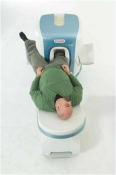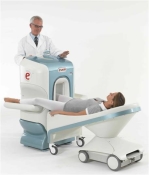 | Info
Sheets |
| | | | | | | | | | | | | | | | | | | | | | | | |
 | Out-
side |
| | | | |
|
| | | | |
Result : Searchterm 'Real' found in 4 terms [ ] and 43 definitions [ ] and 43 definitions [ ] ]
| previous 31 - 35 (of 47) nextResult Pages :  [1] [1]  [2 3 4 5 6 7 8 9 10] [2 3 4 5 6 7 8 9 10] |  | |  | Searchterm 'Real' was also found in the following services: | | | | |
|  |  |
| |
|

It is important to remember when working around a superconducting magnet that the magnetic field is always on. Under usual working conditions the field is never turned off. Attention must be paid to keep all ferromagnetic items at an adequate distance from the magnet. Ferromagnetic objects which came accidentally under the influence of these strong magnets can injure or kill individuals in or nearby the magnet, or can seriously damage every hardware, the magnet itself, the cooling system, etc..
See MRI resources Accidents.
The doors leading to a magnet room should be closed at all times except when entering or exiting the room. Every person working in or entering the magnet room or adjacent rooms with a magnetic field has to be instructed about the dangers. This should include the patient, intensive-care staff, and maintenance-, service- and cleaning personnel, etc..
The 5 Gauss limit defines the 'safe' level of static magnetic field exposure. The value of the absorbed dose is fixed by the authorities to avoid heating of the patient's tissue and is defined by the specific absorption rate.
Leads or wires that are used in the magnet bore during imaging procedures, should not form large-radius wire loops. Leg-to-leg and leg-to-arm skin contact should be prevented in order to avoid the risk of burning due to the generation of high current loops if the legs or arms are allowed to touch. The patient's skin should not be in contact with the inner bore of the magnet.
The outflow from cryogens like liquid helium is improbable during normal operation and not a real danger for patients.
The safety of MRI contrast agents is tested in drug trials and they have a high compatibility with very few side effects. The variations of the side effects and possible contraindications are similar to X-ray contrast medium, but very rare. In general, an adverse reaction increases with the quantity of the MRI contrast medium and also with the osmolarity of the compound.
See also 5 Gauss Fringe Field, 5 Gauss Line, Cardiac Risks, Cardiac Stent, dB/dt, Legal Requirements, Low Field MRI, Magnetohydrodynamic Effect, MR Compatibility, MR Guided Interventions, Claustrophobia, MRI Risks and Shielding. | | | | | | | | | • For this and other aspects of MRI safety see our InfoSheet about MRI Safety. | | | • Patient-related information is collected in our MRI Patient Information.
| | | | | | | | | |  Further Reading: Further Reading: | | Basics:
|
|
News & More:
| |
| |
|  |  | Searchterm 'Real' was also found in the following services: | | | | |
|  |  |
| |
|
(MRS / MRSI - Magnetic Resonance Spectroscopic Imaging) A method using the NMR phenomenon to identify the chemical state of various elements without destroying the sample. MRS therefore provides information about the chemical composition of the tissues and the changes in chemical composition, which may occur with disease processes.
Although MRS is primarily employed as a research tool and has yet to achieve widespread acceptance in routine clinical practice, there is a growing realization that a noninvasive technique, which monitors disease biochemistry can provide important new information for the clinician.
The underlying principle of MRS is that atomic nuclei are surrounded by a cloud of electrons, which very slightly shield the nucleus from any external magnetic field. As the structure of the electron cloud is specific to an individual molecule or compound, then the magnitude of this screening effect is also a characteristic of the chemical environment of individual nuclei.
In view of the fact that the resonant frequency is proportional to the magnetic field that it experiences, it follows that the resonant frequency will be determined not only by the external applied field, but also by the small field shift generated by the electron cloud.
This shift in frequency is called the chemical shift (see also Chemical Shift). It should be noted that chemical shift is a very small effect, usually expressed in ppm of the main frequency. In order to resolve the different chemical species, it is therefore necessary to achieve very high levels of homogeneity of the main magnetic field B0.
Spectra from humans usually require shimming the magnet to approximately one part in 100. High resolution spectra of liquid samples demand a homogeneity of about one part in 1000.
In addition to the effects of factors such as relaxation times that can affect the NMR signal, as seen in magnetic resonance imaging, effects such as J-modulation or the transfer of magnetization after selective excitation of particular spectral lines can affect the relative strengths of spectral lines.
In the context of human MRS, two nuclei are of particular interest - H-1 and P-31. (PMRS - Proton Magnetic Resonance Spectroscopy) PMRS is mainly employed in studies of the brain where prominent peaks arise from NAA, choline containing compounds, creatine and creatine phosphate, myo-inositol and, if present, lactate; phosphorus 31 MR spectroscopy detects compounds involved in energy metabolism (creatine phosphate, adenosine triphosphate and inorganic phosphate) and certain compounds related to membrane synthesis and degradation. The frequencies of certain lines may also be affected by factors such as the local pH. It is also possible to determine intracellular pH because the inorganic phosphate peak position is pH sensitive.
If the field is uniform over the volume of the sample, "similar" nuclei will contribute a particular frequency component to the detected response signal irrespective of their individual positions in the sample. Since nuclei of different elements resonate at different frequencies, each element in the sample contributes a different frequency component. A chemical analysis can then be conducted by analyzing the MR response signal into its frequency components.
See also Spectroscopy. | |  | |
• View the DATABASE results for 'Magnetic Resonance Spectroscopy' (8).
| | |
• View the NEWS results for 'Magnetic Resonance Spectroscopy' (3).
| | | | |  Further Reading: Further Reading: | News & More:
|
|
| |
|  |  | MRI Safety Resources | | | | |
|  |  | |  |  | Searchterm 'Real' was also found in the following services: | | | | |
|  |  |
| |
|


O-scan is manufactured and distributed by Esaote SpA
O-scan is a compact, dedicated extremity MRI system designed for easy installation and high throughput. The complete system fits in a 9' x 10' room, doesn't need for RF or magnetic shielding and it plugs in the wall. The 0.31T permanent magnet along with dual phased array RF coils, and advanced imaging protocols provide outstanding image quality and fast 25 minute complete examinations.
Esaote North America is the exclusive distributor of the O-scan system in the USA.
Device Information and Specification CLINICAL APPLICATION Dedicated Extremity
PULSE SEQUENCES
SE, HSE, HFE, GE, 2dGE, ME, IR, STIR, Stir T2, GESTIR, TSE, TME, FSE STIR, FSE ( T1, T2), X-Bone, Turbo 3DT1, 3D SHARC, 3D SST1, 3D SST2 2D: 2mm - 10 mm, 3D: 0.6 - 10 mm POWER REQUIREMENTS 100/110/200/220/230/240 | |  | | | |
|  |  | Searchterm 'Real' was also found in the following services: | | | | |
|  |  |
| |
|

Manufactured by Esaote S.p.A.;
a low field open MRI scanner with permanent magnet for orthopedic use. The outstanding feature of this MRI system is a patient friendly design with 24 cm diameter, which allows the imaging of extremities and small body parts like shoulder MRI. The power consumption is around 1.3 kW and the needed minimum floor space is an area of 16 sq m.
At RSNA 2006 Hologic Inc. introduced a new dedicated extremity MRI scanner, the Opera. Manufactured by Esaote is the Opera a redesign of Esaote's 0.2 Tesla E-Scan XQ platform, which now enables complete imaging of all extremities, including hip and shoulder applications. ' Real-time positioning' reportedly speeds patient setup and reduces exam times.
Esaote North America and Hologic Inc are the U.S. distributors of this MRI device.
Device Information and Specification CLINICAL APPLICATION Dedicated extremity
SE, GE, IR, STIR, FSE, 3D CE, GE-STIR, 3D GE, ME, TME, HSE IMAGING MODES Single, multislice, volume study, fast scan, multi slab2D: 2 mm - 10 mm;
3D: 0.6 mm - 10 mm 4096 gray lvls, 256 lvls in 3D POWER REQUIREMENTS 2,0 kW; 110/220 V single phase | |  | |
• View the DATABASE results for 'Opera (E-SCAN™ XQ)' (2).
| | | | |  Further Reading: Further Reading: | News & More:
|
|
| |
|  | |  |  |
|  | | |
|
| |
 | Look
Ups |
| |